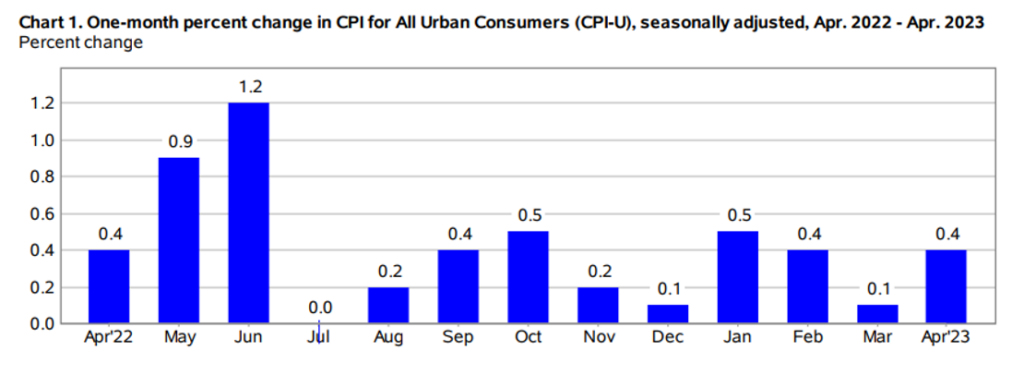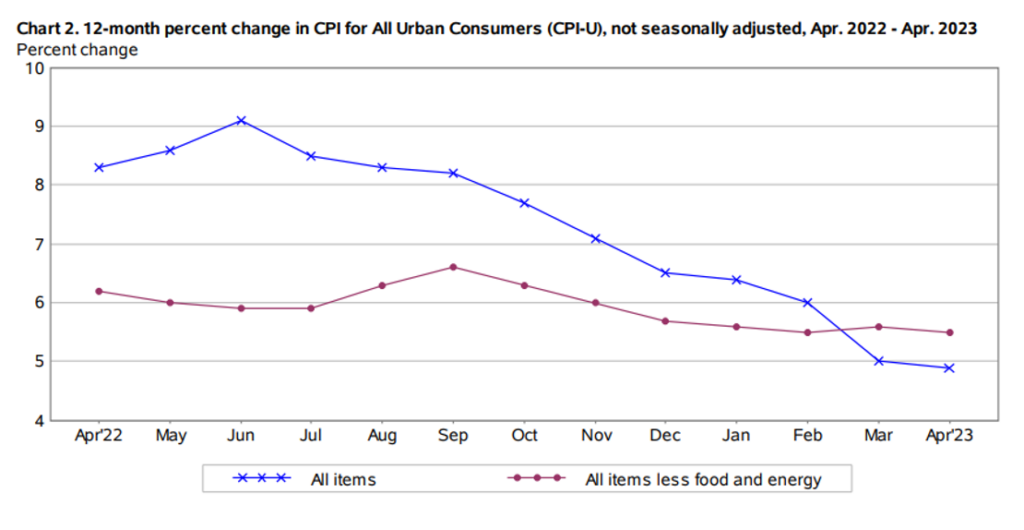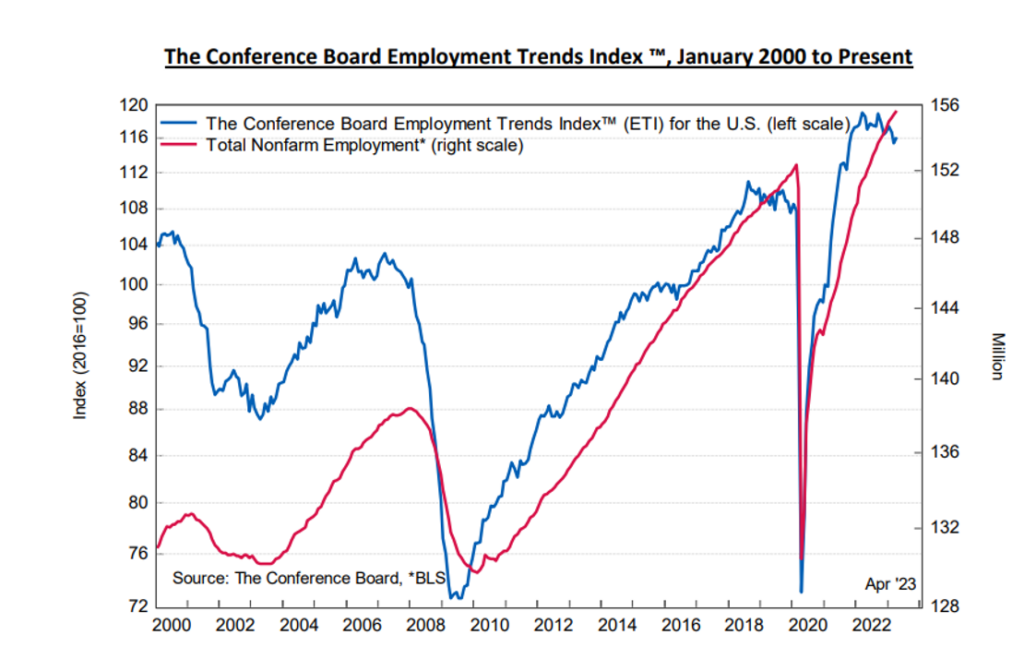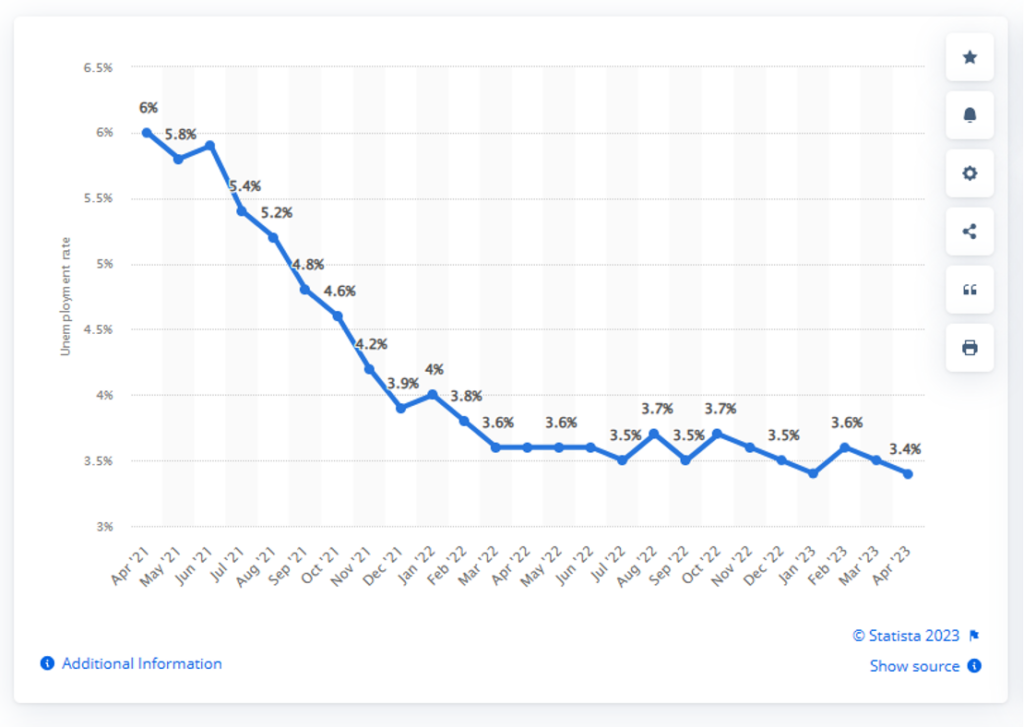KPI — May 2023: State of the Economy

The Consumer Price Index for All Urban Consumers (CPI-U) rose 0.4% in April on a seasonally-adjusted basis after increasing 0.1% in March, according to the U.S. Bureau of Labor Statistics. Over the last 12 months, the all-items index increased 4.9% before seasonal adjustment.

Important Takeaways, Courtesy of the U.S. Bureau of Labor Statistics:
- Categories on the rise in April include used cars and trucks, motor vehicle insurance, recreation, household furnishings and operations, as well as personal care.
- The all-items index increased 4.9% over the last 12 months, with the all items less food and energy index rising 5.5%. The energy index decreased 5.1% year-over-year, while the food index increased 7.7%.

Employment
In April, the unemployment rate and number of unemployed persons remained relatively unchanged at 3.4% and 5.7 million, respectively, according to the U.S. Bureau of Labor Statistics. Similarly, the labor force participation rate was 62.6%, with the long-term unemployed (those jobless for 27 weeks or more) accounting for 20.6% of the total unemployed – up from 18.9% a month prior.
“It is encouraging to see a strong jobs report amid recession concerns, instability in the banking sector and ongoing layoffs,” says Steve Rick, chief economist at CUNA Mutual Group. “We are hopeful the continued strength of the jobs market and signs of slowing inflation will ease market volatility in the coming months.”

The Conference Board Employment Trends Index™ (ETI) increased in April to 116.18, up from a downwardly revised 115.51 in March 2023. The Employment Trends Index is a leading composite index for employment. When the index increases, employment is likely to grow as well, and vice versa. Turning points in the index indicate that a change in the trend of job gains or losses is about to occur in the coming months.
The Conference Board Employment Trends Index™ signals job gains will likely continue, albeit somewhat slower, over the next few months, notes Frank Steemers, senior economist at The Conference Board.
“We continue to forecast a short and mild recession starting in 2023 although it may take until later in the year to see substantial weakening in job growth, or monthly job losses,” he continues.
By Demographic
This month, unemployment rates among the major worker groups: adult women – 3.1%, adult men – 3.3%, teenagers – 9.2%, Asian – 2.8%, White – 3.1%, Hispanic – 4.4% and Black – 4.7%.
Last month, unemployment rates among the major worker groups: adult women – 3.1%, adult men – 3.4%, teenagers – 9.8%, Asian – 2.8%, White – 3.2%, Hispanic – 4.6% and Black – 5%.

Monthly unemployment rate in the U.S. from April 2021 to April 2023 (seasonally-adjusted).
By Industry
Total nonfarm payroll employment rose by 253,000 in April, surpassing Wall Street growth estimates of 180,000 but lower than the average monthly gain of 334,000 during the past six months. According to current data, job growth continued to trend up in professional and business services, health care, leisure and hospitality and social assistance.
“For now, the labor market remains on strong footing with job growth continuing. However, some softening is visible across several labor indicators. Job openings and quits have declined, layoffs have ticked up and compensation growth is softening,” Steemers says. “Still, the labor market remains resilient and tighter than before the pandemic, complicating the Federal Reserve’s efforts to slow inflation.”
Important Takeaways, Courtesy of the U.S. Bureau of Labor Statistics:
- Employment continued to trend up in professional and business services (+43,000). In April, professional, scientific and technical services added 45,000 jobs. Employment in temporary help services continued to trend down over the month (-23,000) and is down by 174,000 since its peak in March 2022.
- Employment in leisure and hospitality continued to trend up (+31,000), largely in food services and drinking places (+25,000). Employment in this industry remains below its pre-pandemic February 2020 level by 402,000, or 2.4%.
- Employment in health care increased by 40,000, compared with the average monthly gain of 47,000 over the prior six months. Over the month, employment continued to trend up in ambulatory health care services (+24,000), nursing and residential care facilities (+9,000) and hospitals (+7,000).
- Employment was little changed month-over-month in other major industries, including construction, manufacturing, wholesale trade, retail trade, transportation and warehousing, information and other services.
Review all employment statistics here.
Steemers says the unique combination of labor shortages and recession risk pose “difficult dilemmas” for employers. According to the Q2 2023 results of The Conference Board Measure of CEO Confidence™, 33% of CEOs expect to expand their workforce over the next 12 months, while 20% expect a net reduction in their workforce and 46% expect little change. The Conference Board has published a new Job Loss Risk Index to help business leaders better understand the risk of layoffs in their industry, in addition to the unique dynamics that the projected recession exposes them to in the process.
KPI — May 2023: Consumer Trends
Key Performance Indicators Report — May 2023



